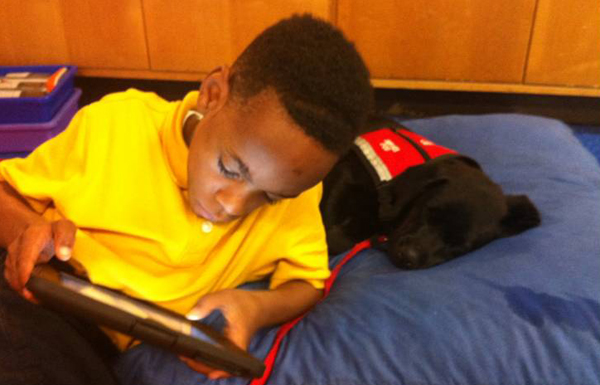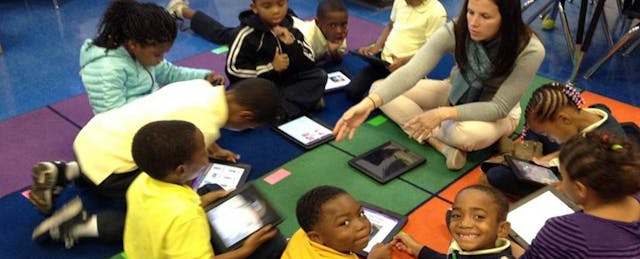Baltimore-based Liberty Elementary School is a refreshing reminder that it is in fact possible to be a neighborhood public school that takes a holistic, 360-degree view of student performance. Far too often in the debate about education reform, we're pitting teachers against technology, or dangerously narrowing our definition of education to academic content mastery as demonstrated by standardized test performance.
In contrast, Liberty Elementary reflects a clear commitment to the whole child, using a balanced investment in experienced staff and community partnerships, and a mix of modern and old-fashioned tools for kids to be creators.
After following Liberty Elementary School principal Joe Manko for a few years on Twitter, I was thrilled to visit his school during their summer session.
Some observations from my visit:
1. The average number of years of teaching experience at Liberty is 14. (Two teachers just celebrated their 42nd year of teaching!) Seeing experienced teachers in action reiterated for me how much we grossly undervalue the power of experience in the public discourse on education reform.
2. Because of the experience level of the teaching staff, and the leadership responsibilities they take on, Joe is the only administrator. No assistant principals, no deans. This helps free up funds for 5 full-time interventionists, a social worker, and a speech pathologist. Note that the school is a 90-90-90 public district school (no admissions requirements): 90% of the students are performing on or above grade-level by the end of the year, 90% are students of color, and 90% qualify for free and reduced lunches.
Photo credit: Joseph Manko

3. The tour of the building was quite a dog and pony show. Literally. Joe actively builds partnerships with community organizations to bring resources into the school. Liberty has a school dog as part of a pet therapy program, and the students have been training service dogs for several years. Students also work with a local farm to bring horses to campus once a month (and daily during the summer). Students use their "behavior bucks" to purchase pony rides (5 Liberty bucks); the full pony package (20 Liberty bucks) gets them a ride and the opportunity to feed, groom, and generally learn how to take care of the animal. An interventionist on our tour referred to this as the humane education movement.
Photo credit: Joseph Manko

4. The children's art was EVERYWHERE. Walls. Ceilings. Windows. Pretty much every inch of space that wasn't covered with student writing samples was covered with art. They'd even wrapped colored ribbons around the railings in the stairwell--just because. Metal trash cans had become painted masterpieces. The net result--a sense of joy, love and warmth in the building.
5. Best (and easy to implement!) display of data to demonstrate student growth in writing: outside of one 2nd grade classroom, each student had three pieces of writing posted side-by-side: from beginning, middle, and end of year. The growth in word choice, sentence structure, and penmanship was a powerful visual display.
Photo credit: Jennifer Medbery

6. Yes, there was technology: in several classrooms, students were on individual iPads researching animals for their reports. I was struck by how unremarkable this was for the students (in a good way)--the iPad was just another tool alongside construction paper, glue, and scissors. A few bulletin boards featured QR codes that linked to students' writeups on volcanoes--again, I noted how subtle this use of technology was.
7. Liberty is building a FabLab in the library and has raised money for 3D printers and other hands-on tools. Kids are already making things with Raspberry Pi, Arduino, and Makey Makey, and learning Scratch through a partnership with the non-profit organization Code in the Schools.
Photo credit: Jennifer Medbery

Liberty Elementary embraces the whole child and intends to keep this focus. “Too often educators feel the need to justify programs by explaining how they’ll improve test scores,” shared Manko. “But sometimes you just have to do things because they're right for kids.”


